Lithium Slag and Solid Waste-Based Binders for Cemented Lithium Mica Fine Tailings Backfill
Abstract
:1. Introduction
2. Materials and Methods
2.1. LS Composite Solid Waste Cementitious Material
2.2. Cemented Aggregate Material
2.3. Experimental Scheme
- (1)
- Cementation performance of LS composite solid waste cementitious material
- (2)
- Experimental study on the cementation of LFT with LSB
- (3)
- Study on the fluidity test of LSB-CLTB
2.4. Experimental Process
- (1)
- Specimen preparation
- (2)
- Slump test
- (3)
- Uniaxial compression test and XRD test
- (4)
- SEM experiments
3. Results and Discussion
3.1. Bonding Properties of Binders
3.2. LSB–CLTB
3.2.1. UCS Test Results
3.2.2. Mechanism Analysis
3.3. Influence of LSB-Cemented LFTs on the Fluidity of Backfill
3.3.1. Results
3.3.2. Mechanism Analysis
3.4. Cost–Benefit Analysis
4. Conclusions
- The optimal OPC:LS:FA:DG ratio for the LSB is 2:1:1:1. The specimens prepared using this proportion demonstrate significant improvements in their UCS compared with the OPC-based samples. Specifically, after curing for 7, 14, and 28 days, the UCS exhibits increases of 8.9, 12.1, and 13.6%, respectively, relative to those of the OPC-based samples.
- The LSB shows superior binding capacity when cementing LFTs. Under identical conditions, the LSB–CLTB specimens exhibit higher compressive strengths than the OPC–CLTB specimens. The CLTB prepared with 10 wt% LSB achieves UCS values of 0.97, 1.52, and 2.1 MPa after 7, 14, and 28 days, satisfactorily meeting the strength requirements for backfilling operations at the Yichun Lithium Mine in Jiangxi.
- The materials within LSB exhibit significant pozzolanic activity. As the curing period increases, the materials with higher levels of pozzolanic activity generate substantial amounts of AFt and C-(A)-S-H gels through hydration reactions, effectively filling the inherent pores within the CLTB. This leads to a denser CLTB, which consequently enhances its mechanical properties. Furthermore, the test results indicate that the fluidity of the LSB-based CLTB slurry satisfies the requirements for actual pipeline transportation in lithium mines.
Author Contributions
Funding
Data Availability Statement
Conflicts of Interest
Abbreviations
| C3S | Tricalcium silicate; chemical formula: 3CaO·SiO2 |
| C2S | Dicalcium silicate; chemical formula: 2CaO·SiO2 |
| C3A | Tricalcium aluminate; chemical formula: 3CaO·Al2O3 |
| C-S-H | Calcium silicate hydrate gel; chemical formula: CaOX·SiO2·(H2O)y |
| C-A-H | Calcium aluminate hydrate gel; chemical formula: CaOX·Al2O3·(H2O)y |
| C-A-S-H | Calcium silico-aluminate hydrate gel; chemical formula: CaOX·(Al2O3)y·SiO2·(H2O)z |
| AFt | Trisulfate hydrate of calcium sulfoaluminate; chemical formula: 3CaO·Al2O3·3CASO4·32H2O |
| CH | Calcium hydroxide; chemical formula: Ca(OH)2 |
| OPC | Cement; the cement referred to in this paper specifically denotes the PO42.5 grade. |
| LSB | Lithium slag composite solid waste cementitious material |
| LSB-CLFT | LSB-cemented lithium mica fine tailings fill material |
| OPC-CLFT | OPC-cemented lithium mica fine tailings fill |
| LS | Lithium slag |
| FA | Fly ash |
| DG | Desulfurization gypsum |
| LFT | Lithium mica fine tailings |
References
- Gao, T.M.; Fan, N.; Chen, W.; Dai, T. Lithium extraction from hard rock lithium ores (spodumene, lepidolite, zinnwaldite, petalite): Technology, resources, environment and cost. China Geol. 2023, 6, 137–153. [Google Scholar]
- Shahjalal, M.; Roy, P.K.; Shams, T.; Fly, A.; Chowdhury, J.I.; Ahmed, R.; Liu, K. A review on second-life of Li-ion batteries: Prospects, challenges, and issues. Energy 2022, 241, 122881. [Google Scholar] [CrossRef]
- Kelly, J.C.; Wang, M.; Dai, Q.; Winjobi, O. Energy, greenhouse gas, and water life cycle analysis of lithium carbonate and lithium hydroxide monohydrate from brine and ore resources and their use in lithium ion battery cathodes and lithium ion batteries. Resour. Conserv. Recycl. 2021, 174, 105762. [Google Scholar] [CrossRef]
- Xiao, E.; Krumins, V.; Tang, S.; Xiao, T.; Ning, Z.; Lan, X.; Sun, W. Correlating microbial community profiles with geochemical conditions in a watershed heavily contaminated by an antimony tailing pond. Environ. Pollut. 2016, 215, 141–153. [Google Scholar] [CrossRef]
- He, X.; Li, W.; Yang, J.; Su, Y.; Zhang, Y.; Zeng, J.; Dai, F.; Tan, H. Multi-solid waste collaborative production of clinker-free cemented iron tailings backfill material with ultra-low binder-tailing ratio. Constr. Build. Mater. 2023, 367, 130271. [Google Scholar] [CrossRef]
- Kou, Y.; Deng, Y.; Tan, Y.; Han, C.; Song, W. Hydration Characteristics and Early Strength Evolution of Classified Fine Tailings Cemented Backfill. Materials 2023, 16, 963. [Google Scholar] [CrossRef] [PubMed]
- Qi, C.; Fourie, A. Cemented paste backfill for mineral tailings management: Review and future perspectives. Miner. Eng. 2019, 144, 106025. [Google Scholar] [CrossRef]
- Kinnunen, P.H.M.; Kaksonen, A.H. Towards circular economy in mining: Opportunities and bottlenecks for tailings valorization. J. Clean. Prod. 2019, 228, 153–160. [Google Scholar] [CrossRef]
- Peng, X.; Guo, L.; Liu, G.; Yang, X.; Chen, X. Experimental Study on Factors Influencing the Strength Distribution of In Situ Cemented Tailings Backfill. Metals 2021, 11, 2059. [Google Scholar] [CrossRef]
- Tariq, A.; Yanful, E.K. A review of binders used in cemented paste tailings for underground and surface disposal practices. J. Environ. Manag. 2013, 131, 138–149. [Google Scholar] [CrossRef]
- Behera, S.K.; Ghosh, C.N.; Mishra, D.P.; Singh, P.; Mishra, K.; Buragohain, J.; Mandal, P.K. Strength development and microstructural investigation of lead-zinc mill tailings based paste backfill with fly ash as alternative binder. Cem. Concr. Compos. 2020, 109, 103553. [Google Scholar] [CrossRef]
- Chen, S.C.; Gao, M.Y.; Lin, W.T.; Liang, J.F.; Li, D.W. Effects of incorporating large quantities of copper tailings with various particle sizes on the strength and pore structure of cement-based materials. Constr. Build. Mater. 2022, 329, 127150. [Google Scholar] [CrossRef]
- Qiu, J.; Guo, Z.; Yang, L.; Jiang, H.; Zhao, Y. Effect of tailings fineness on flow, strength, ultrasonic and microstructure characteristics of cemented paste backfill. Constr. Build. Mater. 2020, 263, 120645. [Google Scholar] [CrossRef]
- Zhao, K.; Zhou, Y.; Huang, Q.; Yin, S.; Yan, Y.; Wu, J.; Shen, L.; Zeng, X.; Liu, W. Early properties and modeling of cemented superfine tailings backfill containing sodium dodecyl sulfate: Microstructure, mechanics, and acoustics. Mech. Mater. 2023, 179, 104567. [Google Scholar] [CrossRef]
- Andrew, R.M. Global CO2 emissions from cement production. Earth Syst. Sci. Data 2018, 10, 195–217. [Google Scholar] [CrossRef]
- Santana-Carrillo, J.L.; Burciaga-Díaz, O.; Escalante-Garcia, J.I. Blended limestone-Portland cement binders enhanced by waste glass based and commercial sodium silicate-Effect on properties and CO2 emissions. Cem. Concr. Compos. 2022, 126, 104364. [Google Scholar] [CrossRef]
- Chen, D.; Hu, X.; Shi, L.; Cui, Q.; Wang, H.; Yao, H. Synthesis and characterization of zeolite X from lithium slag. Appl. Clay Sci. 2012, 59, 148–151. [Google Scholar] [CrossRef]
- Ding, Z.; Ma, W.; Wei, K.; Wu, J.; Zhou, Y.; Xie, K. Boron removal from metallurgical-grade silicon using lithium containing slag. J. Non-Cryst. Solids 2012, 358, 2708–2712. [Google Scholar] [CrossRef]
- Ayati, B.; Newport, D.; Wong, H.; Cheeseman, C. Acid activated smectite clay as pozzolanic supplementary cementitious material. Cem. Concr. Res. 2022, 162, 106969. [Google Scholar] [CrossRef]
- Filho, J.H.; Medeiros MH, F.; Pereira, E.; Helene, P.; Isaia, G.C. High-volume fly ash concrete with and without hydrated lime: Chloride diffusion coefficient from accelerated test. J. Mater. Civ. Eng. 2013, 25, 411–418. [Google Scholar] [CrossRef]
- Janardhan, P.; Krishnaiah, V. An improved mechanical behaviour of fly ash and GGBS based geopolymer concrete. Mater. Today Proc. 2022, 2214–7853. [Google Scholar] [CrossRef]
- Wan, Y.; Hui, X.; He, X.; Xue, J.; Feng, D.; Chen, Z.; Li, J.; Liu, L.; Xue, Q. Utilization of flue gas desulfurization gypsum to produce green binder for dredged soil solidification: Strength, durability, and planting performance. J. Clean. Prod. 2022, 367, 133076. [Google Scholar] [CrossRef]
- Jiang, L.; Li, C.; Wang, C.; Xu, N.; Chu, H. Utilization of flue gas desulfurization gypsum as an activation agent for high-volume slag concrete. J. Clean. Prod. 2018, 205, 589–598. [Google Scholar] [CrossRef]
- Wang, X.; Yu, Y.; Zou, F.; Luo, H.; Zhou, Z.; Zhu, J.; Guo, G.; Zhong, Y. High performance CASH seeds from fly ash-carbide slag for activating lithium slag towards a low carbon binder. J. Environ. Manag. 2023, 345, 118658. [Google Scholar] [CrossRef]
- Yoon, J.; Jafari, K.; Tokpatayeva, R.; Peethamparan, S.; Olek, J.; Rajabipour, F. Characterization and quantification of the pozzolanic reactivity of natural and non-conventional pozzolans. Cem. Concr. Compos. 2022, 133, 104708. [Google Scholar] [CrossRef]
- Liu, T.; Shi, G.; Li, G.; Wang, Z. Study on properties of foamed concrete with EPS as coarse aggregate. IOP Conf. Ser. Mater. Sci. Eng. 2019, 490, 032034. [Google Scholar] [CrossRef]
- Qiu, W.; Hu, W.; Curtin, D.; Motoi, L. Soil particle size range correction for improved calibration relationship between the laser-diffraction method and sieve-pipette method. Pedosphere 2021, 31, 134–144. [Google Scholar] [CrossRef]
- Xue, G.; Yilmaz, E.; Song, W.; Cao, S. Fiber length effect on strength properties of polypropylene fiber reinforced cemented tailings backfill specimens with different sizes. Constr. Build. Mater. 2020, 241, 118113. [Google Scholar] [CrossRef]
- Liu, Z.; Wang, J.; Jiang, Q.; Cheng, G.; Li, L.; Kang, Y.; Wang, D. A green route to sustainable alkali-activated materials by heat and chemical activation of lithium slag. J. Clean. Prod. 2019, 225, 1184–1193. [Google Scholar] [CrossRef]
- Rahman, S.M.A.; Dodd, A.; Khair, S.; Shaikh, F.U.; Sarker, P.K.; Hosan, A. Assessment of lithium slag as a supplementary cementitious material: Pozzolanic activity and microstructure development. Cem. Concr. Compos. 2023, 143, 105262. [Google Scholar] [CrossRef]
- Aldhafeeri, Z.; Fall, M. Sulphate induced changes in the reactivity of cemented tailings backfill. Int. J. Miner. Process. 2017, 166, 13–23. [Google Scholar] [CrossRef]
- Feng, Y.; Kero, J.; Yang, Q.; Chen, Q.; Engström, F.; Samuelsson, C.; Qi, C. Mechanical activation of granulated copper slag and its influence on hydration heat and compressive strength of blended cement. Materials 2019, 12, 772. [Google Scholar] [CrossRef] [PubMed]
- Zhang, Q.; Chen, Q.; Wang, X. Cemented backfilling technology of paste-like based on aeolian sand and tailings. Minerals 2016, 6, 132. [Google Scholar] [CrossRef]
- GB/T 2419-2005; Test Method for Flow of Cement Mortar. China Building Material Industry Association: Beijing, China, 2005.
- Chen, Q.; Zhang, Q.; Fourie, A.; Xin, C. Utilization of phosphogypsum and phosphate tailings for cemented paste backfill. J. Environ. Manag. 2017, 201, 19–27. [Google Scholar] [CrossRef]
- Qi, C.; Chen, Q.; Fourie, A.; Qi, C.; Chen, Q.; Fourie, A.; Zhao, J.; Zhang, Q. Pressure drop in pipe flow of cemented paste backfill: Experimental and modeling study. Powder Technol. 2018, 333, 9–18. [Google Scholar] [CrossRef]
- Xiu, Z.; Wang, S.; Ji, Y.; Wang, F.; Ren, F.; Nguyen, V.T. Loading rate effect on the uniaxial compressive strength (UCS) behavior of cemented paste backfill (CPB). Constr. Build. Mater. 2021, 271, 121526. [Google Scholar] [CrossRef]
- Zhou, S.; Li, X.; Zhou, Y.; Min, C.; Shi, Y. Effect of phosphorus on the properties of phosphogypsum-based cemented backfill. J. Hazard. Mater. 2020, 399, 122993. [Google Scholar] [CrossRef]
- Feng, Y.; Yang, Q.; Chen, Q.; Kero, J.; Andersson, A.; Ahmed, H.; Engström, F.; Samuelsson, C. Characterization and evaluation of the pozzolanic activity of granulated copper slag modified with CaO. J. Clean. Prod. 2019, 232, 1112–1120. [Google Scholar] [CrossRef]
- Niroshan, N.; Yin, L.; Sivakugan, N.; Veenstra, R.L. Relevance of SEM to long-term mechanical properties of cemented paste backfill. Geotech. Geol. Eng. 2018, 36, 2171–2187. [Google Scholar] [CrossRef]
- Wu, P.; Wang, J.; Hu, S.; Cao, X.; Lyu, X. Preparation and performance of slag-based binders for the cementation of fine tailings. J. Adhes. Sci. Technol. 2018, 32, 976–996. [Google Scholar] [CrossRef]
- Hu, Y.; Ren, X.; Ye, J.; Luan, Z.; Xiao, Y.; Zhang, W. Performance of a steel slag-based supplementary cementitious material via the synergistic modification of binary fly ash and gypsum system. Constr. Build. Mater. 2023, 405, 133186. [Google Scholar] [CrossRef]
- Li, J.; Yilmaz, E.; Cao, S. Influence of solid content, cement/tailings ratio, and curing time on rheology and strength of cemented tailings backfill. Minerals 2020, 10, 922. [Google Scholar] [CrossRef]
- Allen, A.J.; Thomas, J.J.; Jennings, H.M. Composition and density of nanoscale calcium–silicate–hydrate in cement. Nat. Mater. 2007, 6, 311–316. [Google Scholar] [CrossRef] [PubMed]
- He, Y.; Chen, Q.; Qi, C.; Zhang, Q.; Xiao, C. Lithium slag and fly ash-based binder for cemented fine tailings backfill. J. Environ. Manag. 2019, 248, 109282. [Google Scholar] [CrossRef] [PubMed]
- Wu, F.F.; Shi, K.B.; Dong, S.K. Properties and microstructure of HPC with lithium-slag and fly ash. Key Eng. Mater. 2014, 599, 70–73. [Google Scholar] [CrossRef]
- Wu, F.F.; Shi, K.B.; Dong, S.K. Influence of concrete with lithium-slag and steel slag by early curing conditions. Key Eng. Mater. 2014, 599, 52–55. [Google Scholar] [CrossRef]
- Huang, Z.; Cao, S.; Yilmaz, E. Microstructure and mechanical behavior of cemented gold/tungsten mine tailings-crushed rock backfill: Effects of rock gradation and content. J. Environ. Manag. 2023, 339, 117897. [Google Scholar] [CrossRef]
- Mendoza, F.; Lu, R. Basics of image analysis. In Hyperspectral Imaging Technology in Food and Agriculture; Springer Science+Business Media: New York, NY, USA, 2015; pp. 9–56. [Google Scholar]
- Zheng, J.; Sun, X.; Guo, L.; Zhang, S.; Chen, J. Strength and hydration products of cemented paste backfill from sulphide-rich tailings using reactive MgO-activated slag as a binder. Constr. Build. Mater. 2019, 203, 111–119. [Google Scholar] [CrossRef]
- Wang, J.; Fu, J.; Song, W.; Zhang, Y. Effect of rice husk ash (RHA) dosage on pore structural and mechanical properties of cemented paste backfill. J. Mater. Res. Technol. 2022, 17, 840–851. [Google Scholar] [CrossRef]
- Cihangir, F.; Ercikdi, B.; Kesimal, A.; Ocak, S.; Akyol, Y. Effect of sodium-silicate activated slag at different silicate modulus on the strength and microstructural properties of full and coarse sulphidic tailings paste backfill. Constr. Build. Mater. 2018, 185, 555–566. [Google Scholar] [CrossRef]
- Zhang, Y.; Yu, P.; Pan, F.; He, Y. The synergistic effect of AFt enhancement and expansion in Portland cement-aluminate cement-FGD gypsum composite cementitious system. Constr. Build. Mater. 2018, 190, 985–994. [Google Scholar] [CrossRef]
- Zhang, S.; Shi, T.; Ni, W.; Li, K.; Gao, W.; Wang, K.; Zhang, Y. The mechanism of hydrating and solidifying green mine fill materials using circulating fluidized bed fly ash-slag-based agent. J. Hazard. Mater. 2021, 415, 125625. [Google Scholar] [CrossRef] [PubMed]
- Fu, J.X.; Wang, K.; Wang, J. Internal pore evolution and early hydration characterization of fly ash cement backfill. J. Build. Eng. 2023, 72, 106716. [Google Scholar] [CrossRef]
- Yang, P.; Liu, L.; Suo, Y.; Qu, H.; Xie, G.; Zhang, C.; Deng, S.; Lv, Y. Investigating the synergistic effects of magnesia-coal slag based solid waste cementitious materials and its basic characteristics as a backfill material. Sci. Total Environ. 2023, 880, 163209. [Google Scholar] [CrossRef] [PubMed]
- Mikheenkov, M.A.; Sheshukov, O.Y.; Lobanov, D.A. Reduction of environmental pressure by giving cementing material properties to the ferrous slags. KnE Mater. Sci. 2017, 2017, 65–69. [Google Scholar] [CrossRef]
- Xu, S.; Xu, Z.; Ji, Y. Preparation and Mechanical Properties of Low Carbon Cementitious Materials with Superfine Cement Reverse Filling High-Volume Mineral Admixtures. Materials 2023, 16, 4814. [Google Scholar] [CrossRef] [PubMed]
- Luo, Q.; Liu, Y.; Dong, B.; Ren, J.; He, Y.; Wu, K.; Wang, Y. Lithium slag-based geopolymer synthesized with hybrid solid activators. Constr. Build. Mater. 2023, 365, 130070. [Google Scholar] [CrossRef]
- He, Y.; Kang, Q.; Lan, M.; Peng, H. Mechanism and assessment of the pozzolanic activity of melting-quenching lithium slag modified with MgO. Constr. Build. Mater. 2023, 363, 129692. [Google Scholar] [CrossRef]
- Sarkar, G.; Siddiqua, S. Effect of fluid chemistry on the microstructure of light backfill: An X-ray CT investigation. Eng. Geol. 2016, 202, 153–162. [Google Scholar] [CrossRef]
- Huang, Y.; Zhao, X.; Zhang, R.; Xie, P.; Xue, G.; Ma, G. Environmental economic profiles of expressway construction via life cycle assessment. Environ. Impact Assess. Rev. 2024, 104, 107359. [Google Scholar] [CrossRef]

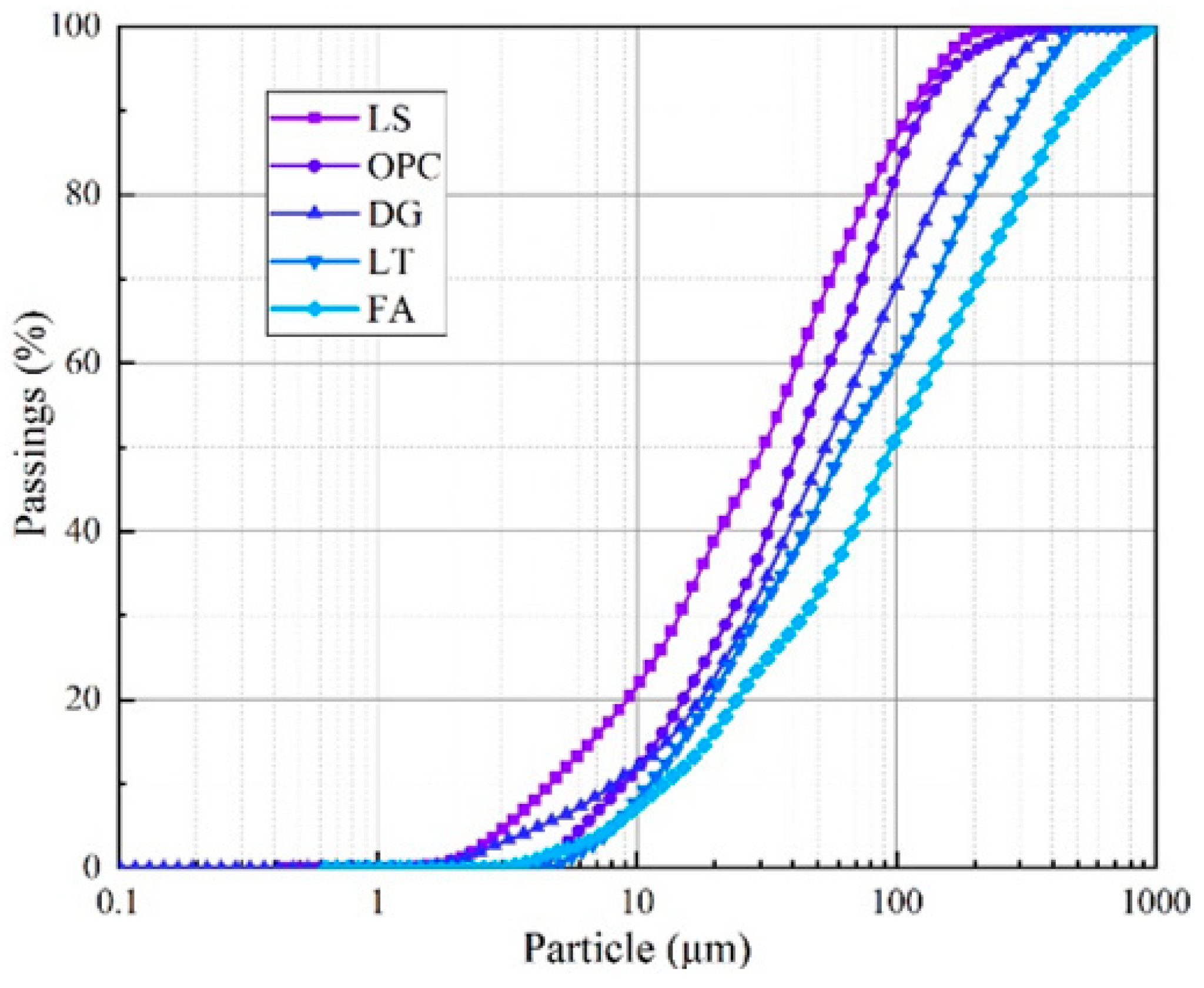
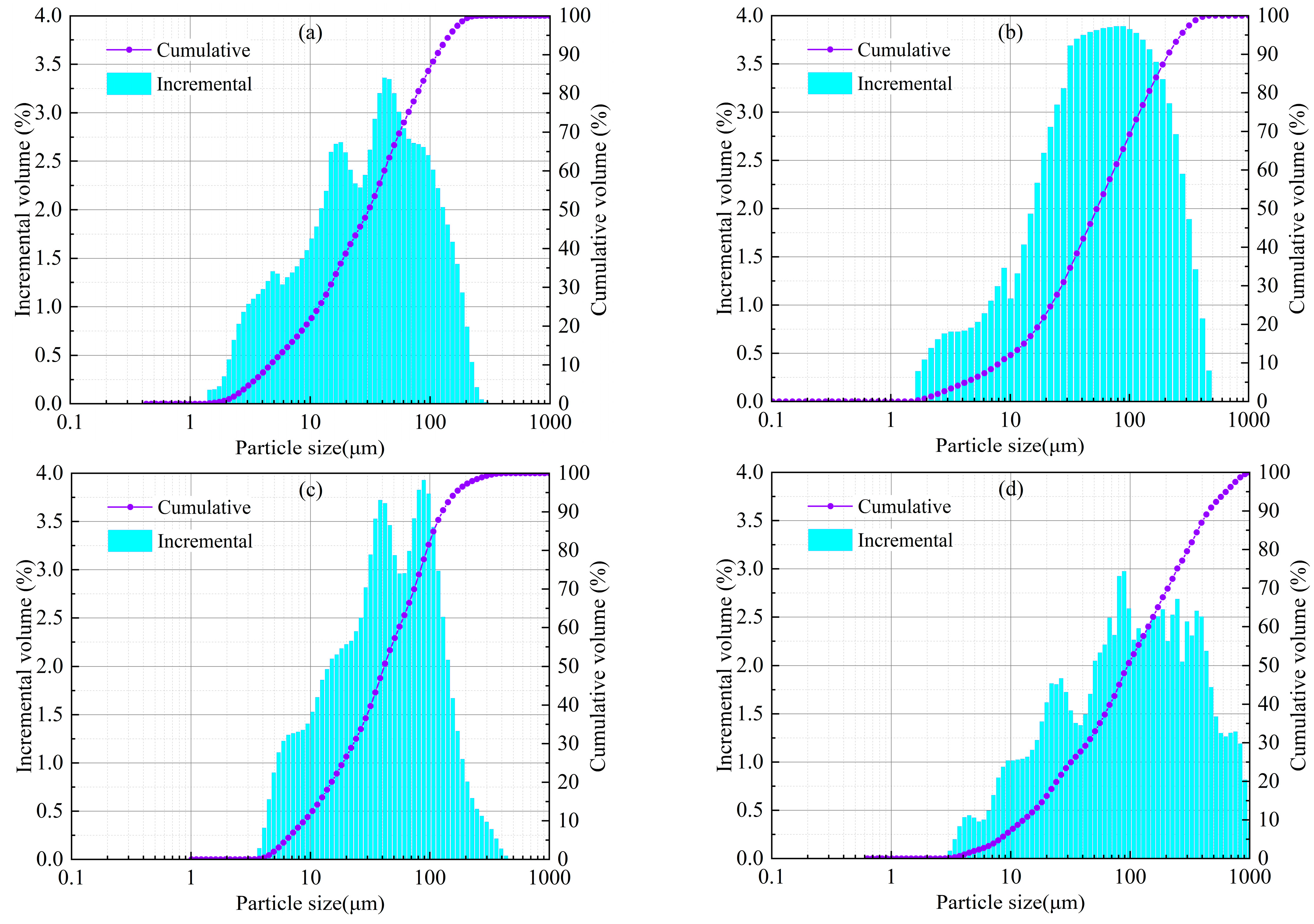
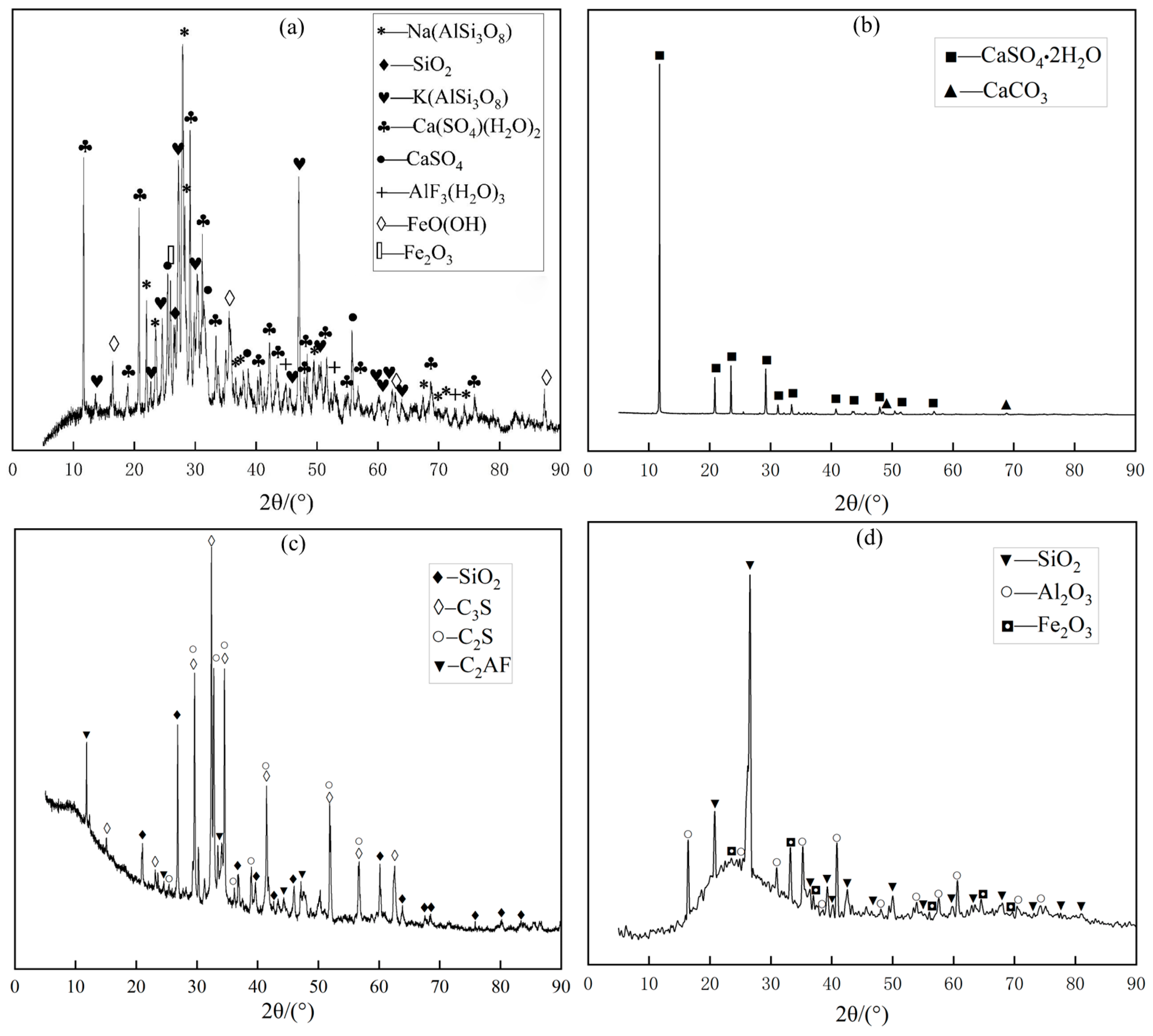
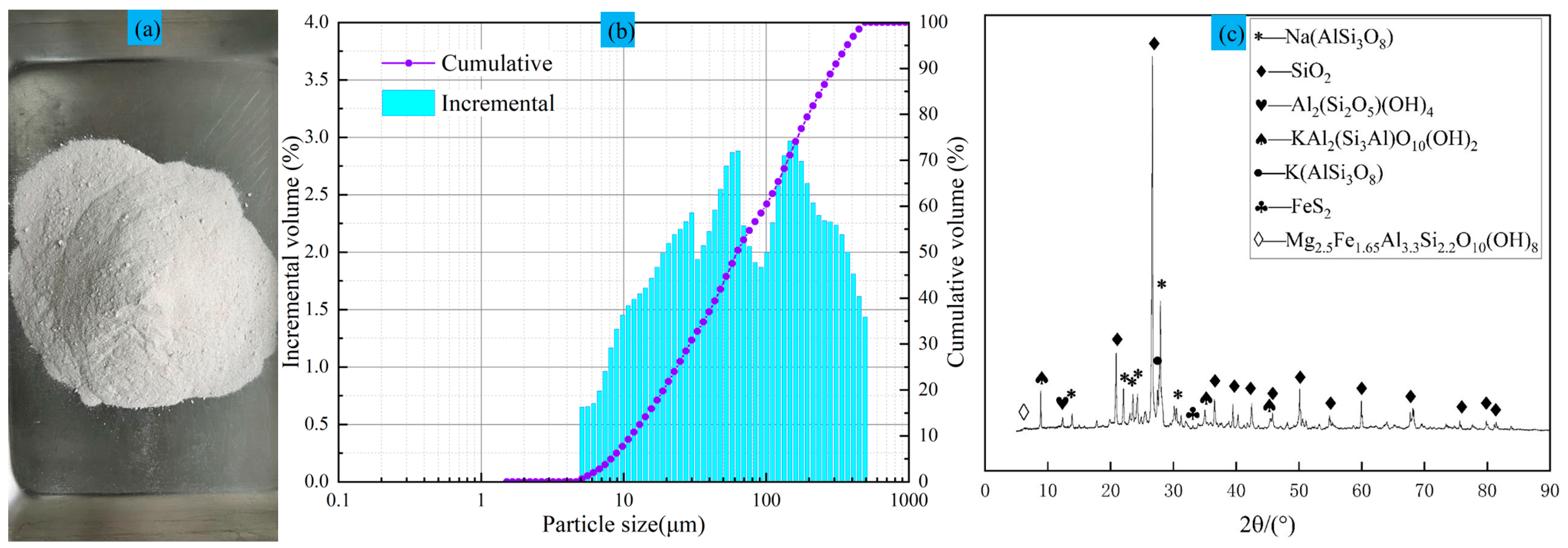
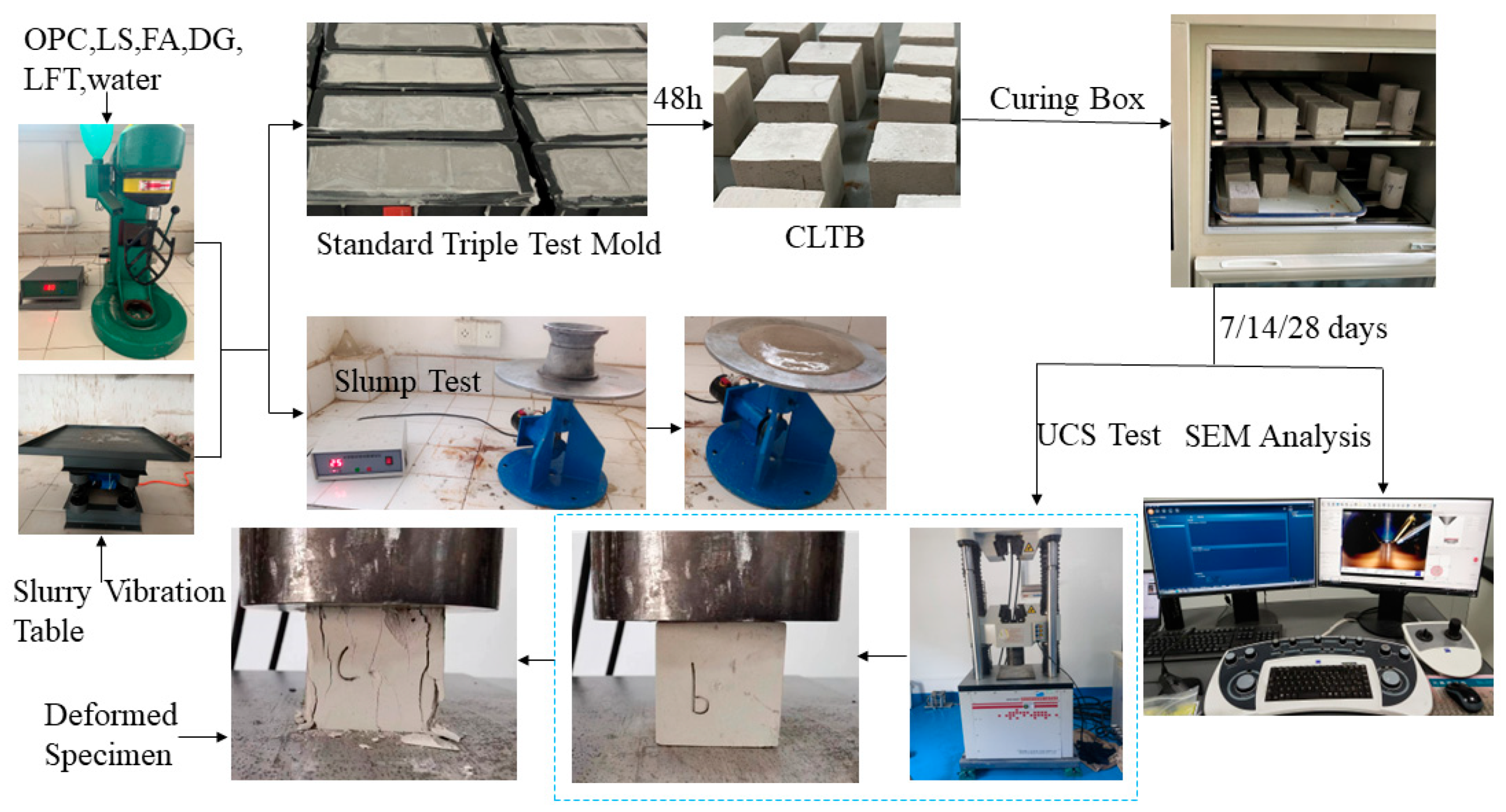
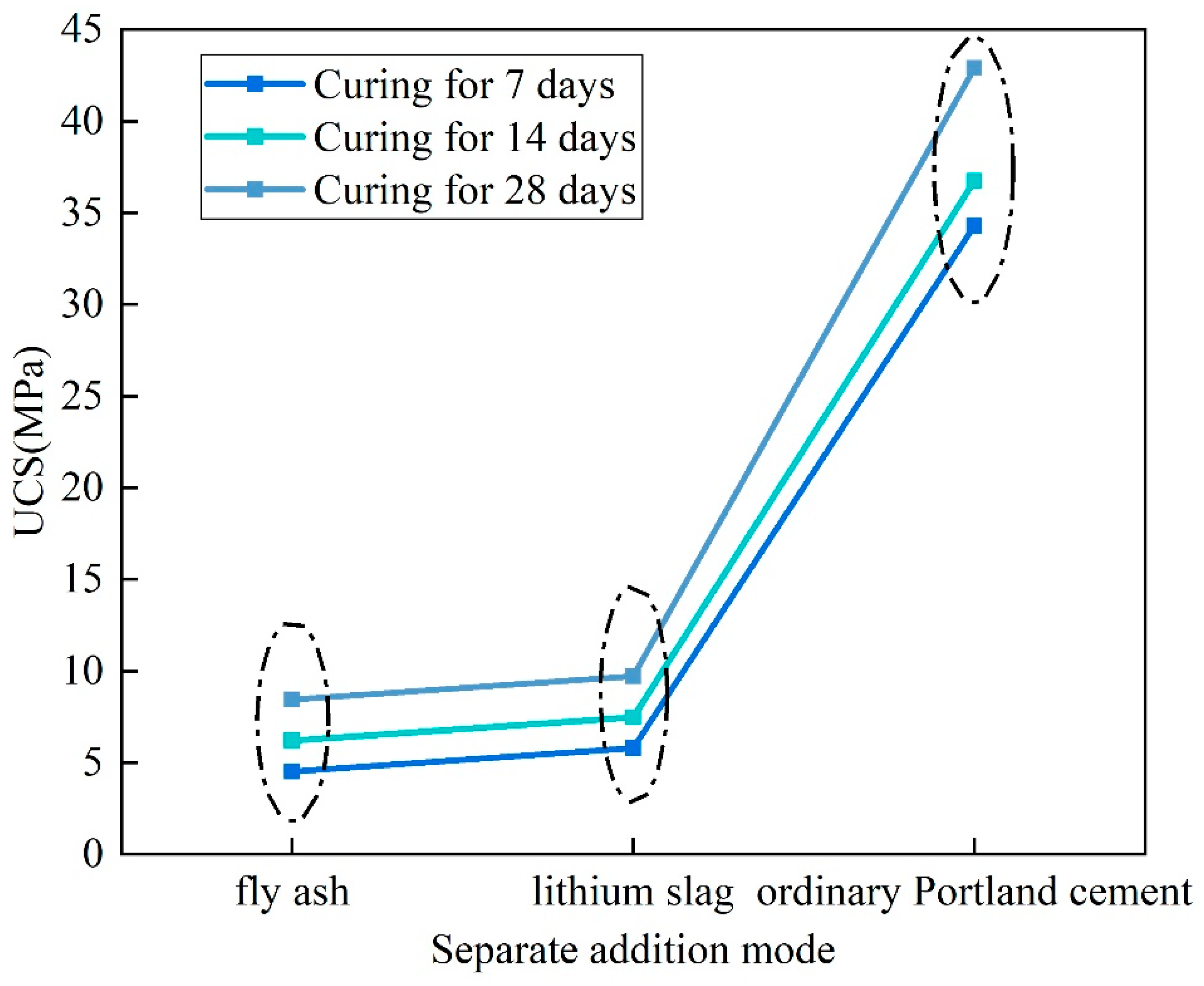






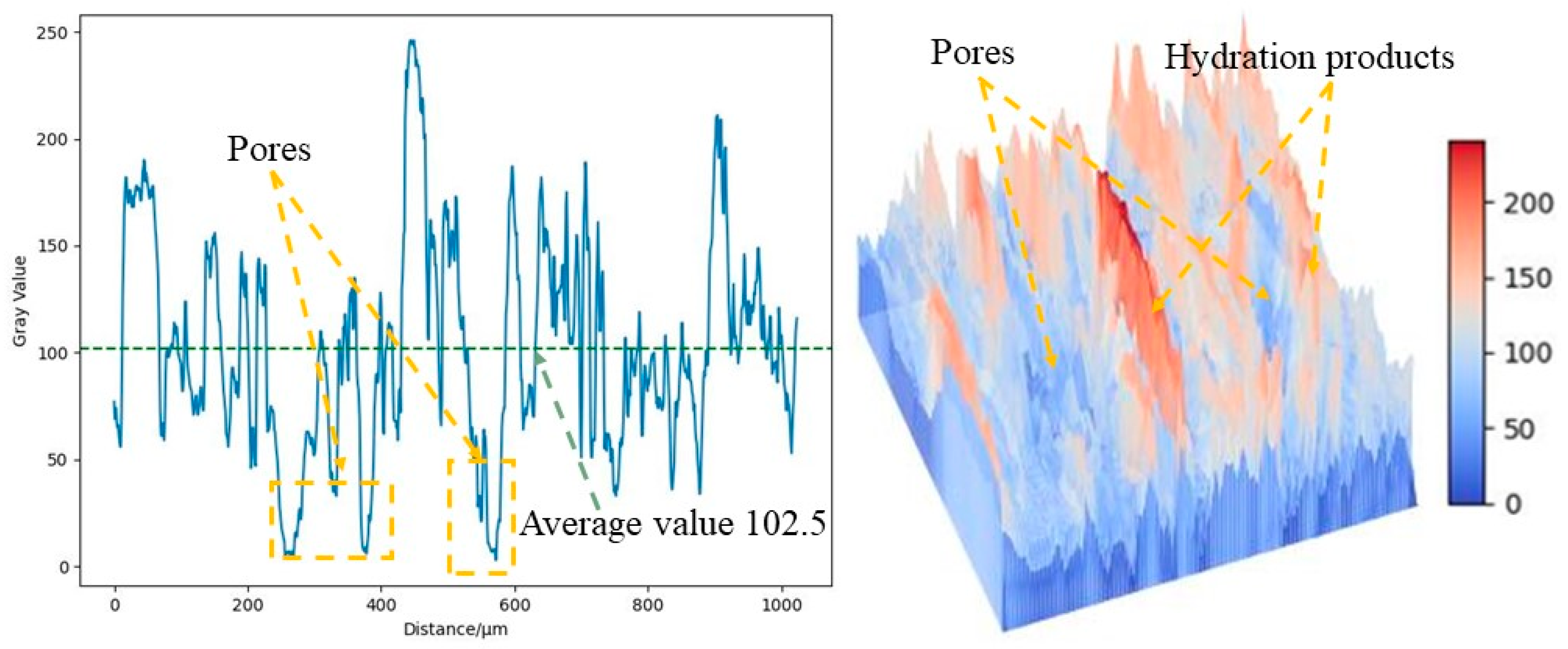

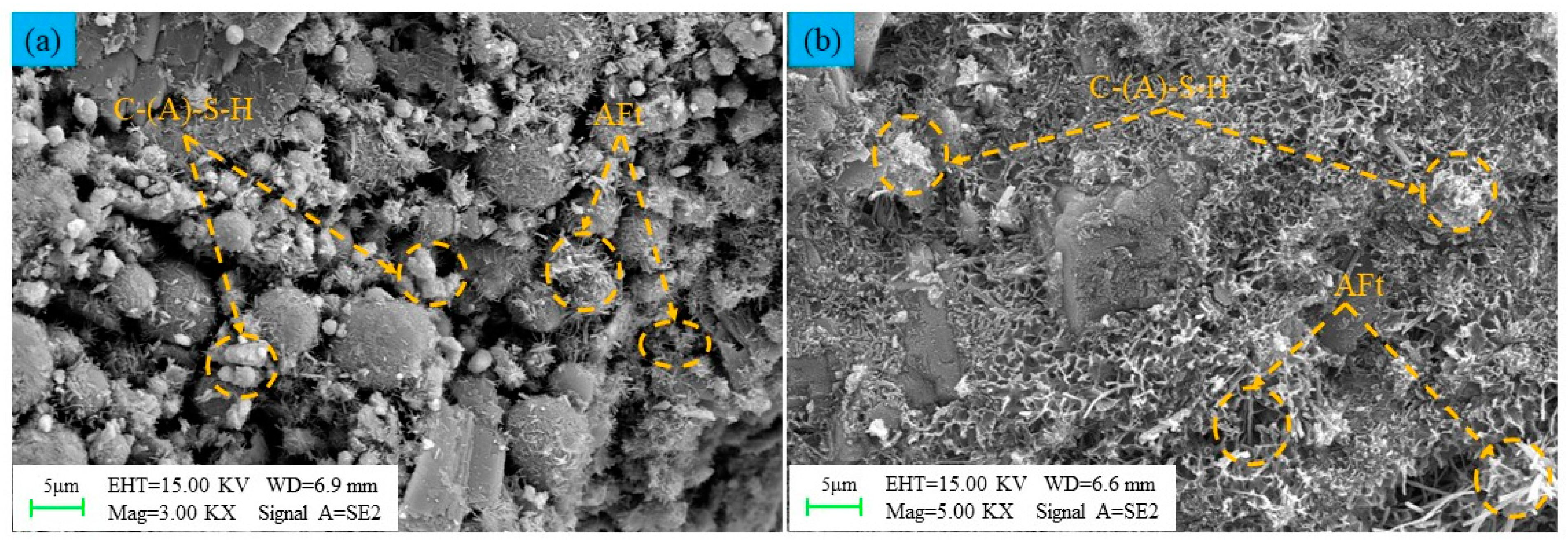

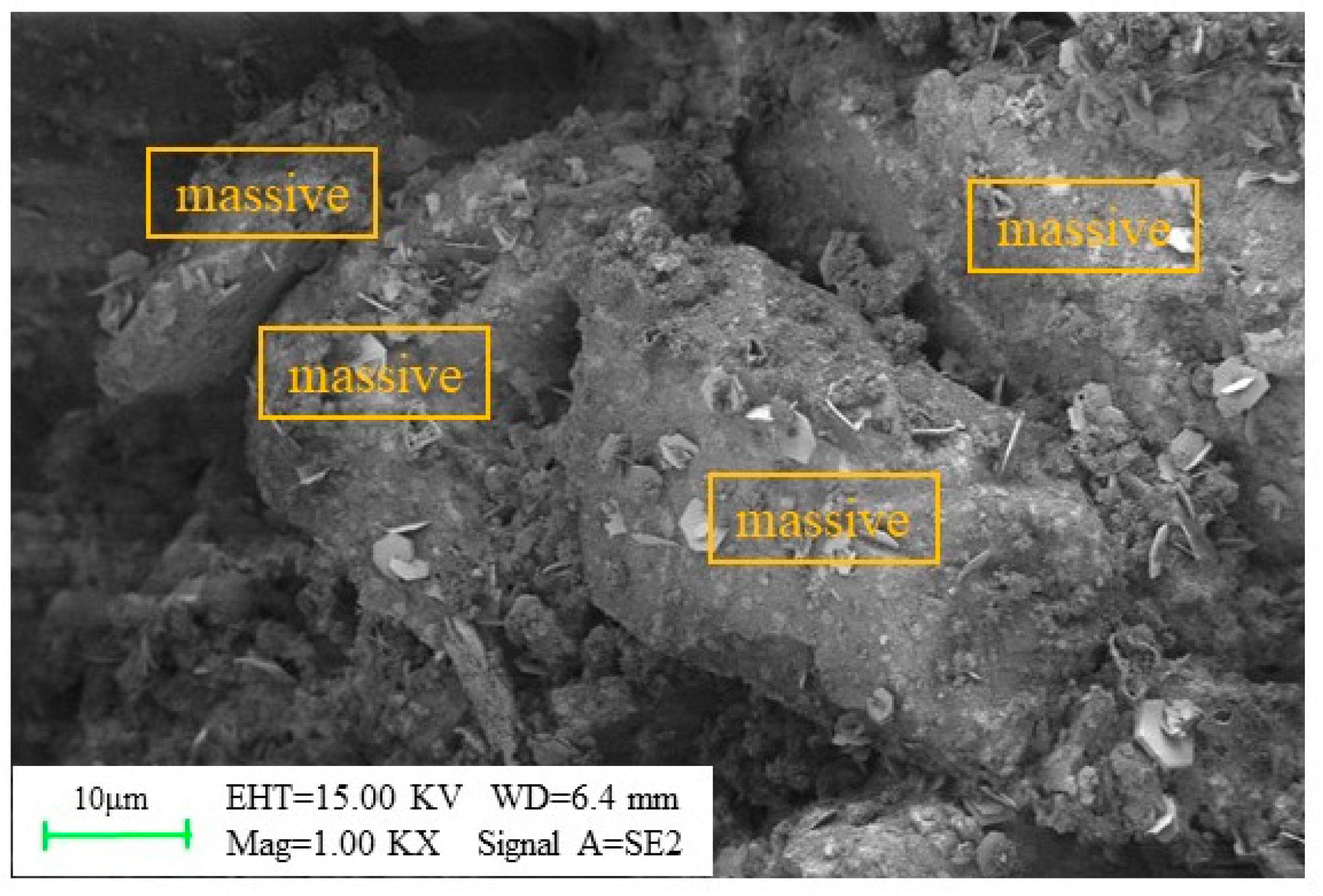
| Material | d(bar) (μm) | d10 (μm) | d30 (μm) | d60 (μm) | Cu | Cc | pH |
|---|---|---|---|---|---|---|---|
| LS | 34.58 | 4.88 | 14.94 | 41.67 | 8.54 | 1.1 | 5.5 |
| DG | 53.04 | 8.9 | 28.07 | 77.94 | 8.76 | 1.14 | 7.8 |
| OPC | 42.18 | 9.48 | 24.1 | 55.8 | 5.87 | 1.1 | 12.8 |
| FA | 97.63 | 13.77 | 46.29 | 141.78 | 10.3 | 1.1 | 11.6 |
| LFT | 63.27 | 11.8 | 30 | 100.87 | 8.55 | 0.76 | 6.7 |
| Components | LS | DG | OPC | FA | |
|---|---|---|---|---|---|
| Chemical composites (%) | SiO2 | 25.79 | 0.99 | 23.9 | 52.16 |
| Al2O3 | 16.84 | 0.08 | 8.59 | 24.2 | |
| CaO | 29.17 | 36.9 | 52.8 | 6.4 | |
| Na2O | 0.28 | — | 0.46 | — | |
| MgO | 0.56 | 0.84 | 3.72 | 1.34 | |
| Fe2O3 | 2.68 | 0.42 | 4.38 | 10.87 | |
| K2O | 3.87 | 0.02 | 1 | — | |
| SO3 | 9.75 | 52.17 | 4.13 | 1.3 | |
| LOI | 4.58 | 6.26 | 1.12 | 2.8 |
| No. | Materials | Water–Binder Ratio | Curing Time | |||
|---|---|---|---|---|---|---|
| A:OPC | B:LS | C:FA | D:DG | |||
| 1 | 5 | 0 | 0 | 0 | 0.6 | 7 days |
| 2 | 0 | 5 | 0 | 0 | 14 days | |
| 3 | 0 | 0 | 5 | 0 | 28 days | |
| 4 | 1 | 0 | 1 | 3 | ||
| 5 | 1 | 1 | 3 | 0 | ||
| 6 | 1 | 3 | 0 | 1 | ||
| 7 | 2 | 0 | 1 | 2 | ||
| 8 | 2 | 1 | 2 | 0 | ||
| 9 | 2 | 2 | 0 | 1 | ||
| 10 | 2 | 1 | 1 | 1 | ||
| 11 | 3 | 1 | 1 | 0 | ||
| 12 | 3 | 1 | 0 | 1 | ||
| 13 | 3 | 0 | 1 | 1 | ||
Disclaimer/Publisher’s Note: The statements, opinions and data contained in all publications are solely those of the individual author(s) and contributor(s) and not of MDPI and/or the editor(s). MDPI and/or the editor(s) disclaim responsibility for any injury to people or property resulting from any ideas, methods, instructions or products referred to in the content. |
© 2023 by the authors. Licensee MDPI, Basel, Switzerland. This article is an open access article distributed under the terms and conditions of the Creative Commons Attribution (CC BY) license (https://creativecommons.org/licenses/by/4.0/).
Share and Cite
Li, J.; Huang, J.; Hu, Y.; Zhu, D. Lithium Slag and Solid Waste-Based Binders for Cemented Lithium Mica Fine Tailings Backfill. Materials 2023, 16, 7572. https://doi.org/10.3390/ma16247572
Li J, Huang J, Hu Y, Zhu D. Lithium Slag and Solid Waste-Based Binders for Cemented Lithium Mica Fine Tailings Backfill. Materials. 2023; 16(24):7572. https://doi.org/10.3390/ma16247572
Chicago/Turabian StyleLi, Jiafeng, Jinsong Huang, Yali Hu, and Daopei Zhu. 2023. "Lithium Slag and Solid Waste-Based Binders for Cemented Lithium Mica Fine Tailings Backfill" Materials 16, no. 24: 7572. https://doi.org/10.3390/ma16247572
APA StyleLi, J., Huang, J., Hu, Y., & Zhu, D. (2023). Lithium Slag and Solid Waste-Based Binders for Cemented Lithium Mica Fine Tailings Backfill. Materials, 16(24), 7572. https://doi.org/10.3390/ma16247572





